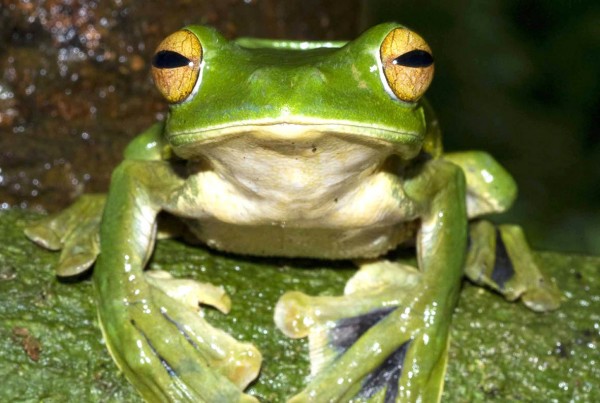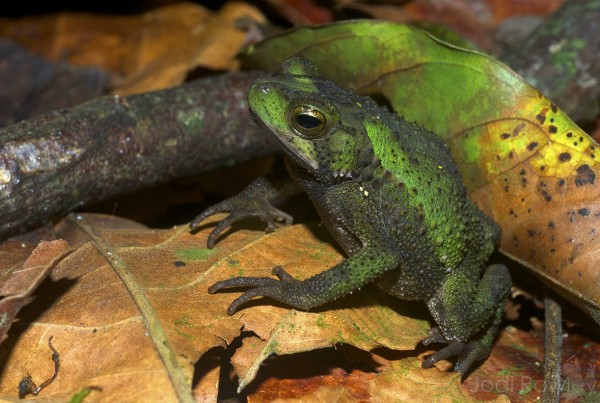Healthy salamander populations on both sides of the planet may depend on controlling the international sale of Asian newts as pets.
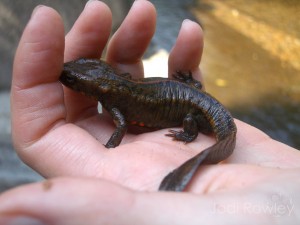
Hong Kong Newt (Paramesotriton hongkongensis), Hong Kong
Salamanders are popular as pets in many countries. To satisfy this demand, they are harvested from the wild and transported across the planet. But moving animals around the world also moves their parasites and pathogens. Recently, a newly discovered species of chytrid fungus appears to have hitchhiked to Europe on the skin of imported pet Asian salamanders of the family Salamandridae (‘newts’). Researchers have determined that Asian newts have co-existed with this fungus for perhaps 30 million years, and during that time evolved some protection from it. Unfortunately, laboratory experiments have shown that the fungus can be deadly to salamanders that have never been exposed to it, elsewhere in the world (more).
Scientists have rightly recommended that the international trade of live salamanders be more tightly controlled to prevent the spread of this fungal pathogen into European and North American salamander populations. But the plight of the Asian newts, which are threatened by overharvesting for the same pet trade, has received little attention. Controlling the global trade of live salamanders is vital to ensuring the survival of the Asian newts, too.
The tailed amphibians, or salamanders, are beautiful and usually gentle creatures, so it’s not surprising that people enjoy keeping them in terraria and aquaria as pets. However, to supply the pet trade, wild salamanders are collected from around the world, especially the rainforests of Central America and the cool, mountain streams of Asia.
A recent paper reported that a newly discovered amphibian chytrid fungus Batrachochytrium salamandrivorans (Bs) likely originated in Asia and hitchhiked to Europe on the skin of wild Asian newts imported to supply the pet trade.
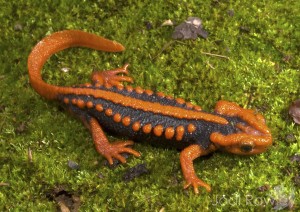
Emperor Newt (Tylototriton shanjing), China
The paper raised alarm that Bs now poses a threat to wild populations of European and North American salamanders. Already wild salamander populations in Europe appear to be declining. While this paper rightly sparked global alarm for the future of European and North American salamanders, the conservation crisis facing Asian newts themselves has not received enough attention.
More than one-third of all species of Southeast and East Asian newts are at risk of extinction, many due to overharvesting for the international pet trade. The Lao Newt (Laotriton laoensis) is an unusual, colorful species that lives only in a small part of northern Laos, and outside of any the country’s protected areas (more).
Shortly after the species was discovered and described to science in 2002, commercial collectors from Germany and Japan visited villages in Laos to obtain these rare newts for sale into the pet trade back at home (more). The government of Laos has since passed legislation banning the commercial trade of the newts in Laos, but unfortunately, illegal trade continues today. Many of the people who live near the Lao Newt are poor and unable to resist the money offered to them by illegal collectors, who then re-sell the newts to pet markets in Europe, Japan and the United States. Sadly, the Lao Newt is now Endangered in the wild, primarily due to illegal harvesting for the international pet trade.
Despite their protection in Laos, little can be done to stop the transportation and sale of Lao Newts once they leave the country, destined for the pet trade abroad. For example, no Asian newt species are currently listed in the Convention on International Trade in Endangered Species of Wild Fauna and Flora (CITES), an international agreement that is intended to protect certain species from overexploitation.
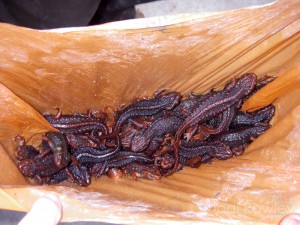
Crocodile Newts (Tylototriton sp.) harvested from the wild, China
The discovery of the origin of Bs presents a renewed opportunity to curb the sale of live Asian newts around the world. Lao Newts have not yet been tested for Bs, but the fungus has been in three other, very closely related species of Asian newts, and the Lao Newt probably carries it. Controlling the trade of live Asian newts will prevent European and North American salamanders from being further exposed to this fungal pathogen- and will also keep Asian newts safe in the wild.
Fortunately, some countries, including Australia, do not allow importing salamanders as pets. Other countries should follow suit to protect wild salamanders. In the meantime, many Asian newt species should be listed in the CITES convention. And countries around the world need to control the importation of live Asian newts as seriously as they do live poultry and livestock that also pose disease risks to domestic populations. Western and Asian countries should work together to curb the trade of live Asian newts. Doing so will keep Asian newts in the wild and the Western salamanders fungus-free. Otherwise, a global catastrophe to our world’s salamanders awaits.
Dr Jodi Rowley
Australian Museum Research Institute
Dr Bryan Stuart
North Carolina Museum of Natural Sciences
More information:
Stuart, B. L., Rowley, J.J.L., Phimmachak, S., Aowphol, A. & Sivongxay, N. (2014). Salamander protection starts with the newt. Science 346 (6213): 1067-1068.

